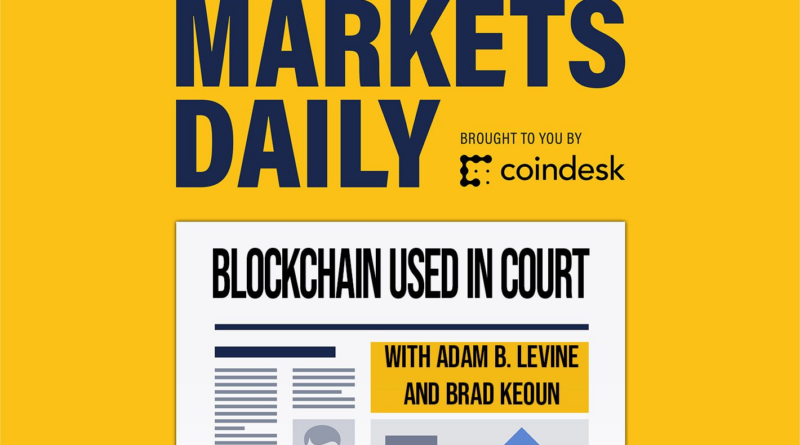MARKETS DAILY: Weird News Out of Canada and a Predicted Bull Run – CoinDesk
Bitcoin was flat this weekend but there are some bullish signals. Plus we talk about some weird news out of Canada, arrests in Asia after a suspect extortion plot, and one bright spot for blockchain in Asia…
Tune in as CoinDesk podcasts editor Adam B. Levine and senior markets reporter Brad Keoun run down recent action, track interesting longer-term trends, and highlight the best "thinking with tokens" and some of the most important crypto industry developments of the day.
No time to listen? Scroll down for the transcript.
Having trouble with the embedded player? You can download the MP3 here.
In this episode:
More ways to Listen or Subscribe
Transcript
Adam B. Levine: On Today’s episode, we’re exploring the market as we enter the holidays, justice on the blockchain, and a look at security tokens.
It’s December 16 2019, and you’re listening to Markets Daily, I’m Adam B. Levine, editor of Podcasts here At Coindesk, along with our senior markets reporter, Brad Keoun, to give you a concise daily briefing on crypto markets and some of the most important news developments in the sector over the past 24 hours.
First, we turn to the daily bitcoin market briefing and the important news affecting the crypto industry
Brad Kuen: Bitcoin is right around $7100 with not much change over the weekend. CoinDesk’s Omkar Godbole writes that price charts are looking bearish, potentially heading back toward $6500 during the holiday. Prices would have to climb above $7870 to signal a short-term bullish reversal or above $8500 for a convincing start of a new bullish trend. The good news? This is far from the market low we hit a year ago on December 15 and prices are up 127% since then.
The price has been stable, which has defied some market prognosticators’ call for a big bull run into bitcoin’s expected mining-reward halving in May 2020. We’ll have more clarity on that in the new year.
In Bull News, Mark Yusko, CEO of the money-management firm Morgan Creek Capital Management, was once a skeptic of bitcoin. But he told Business Insider recently that he sees the price going to $100,000 by 2021, and potentially all the way to $500,000 by 2030.
Turning to the news, Chinese media are reporting that police arrested the CEO of MicroBT, a Chinese manufacturer of computers used to mine bitcoin. The arrest happened in October and the CEO, Yang ZUO SHING, previously worked at the dominant industry leader, Bitmain, where he was mining chip design director. According to the report, the CEO is accused of embezzling $15,000
Bitmain has a pending civil case against Yang and MicroBT, alleging the former employee of infringing a Bitmain patent on bitcoin mining equipment
Separately, CoinDesk’s Wolfie Zhou reports that a district court in Shenzhen ordered the freezing of $680,000 in assets belonging to a unit of Bitmain over a contract dispute with an electronics supplier.
Coming back to the US, Fidelity Digital Assets, a unit of the giant asset manager Fidelity, might enable support for ethereum, the world’s second-largest cryptocurrency, as soon as next year.
According to reports, Tom Jessop, the unit’s president, said that it has so far only supported bitcoin because it has a longer track record
Finally, we offer some news of the weird. Lingering suspicions over the death of Gerald Cotten, former CEO of the defunct crypto exchange QuadrigaCX, have led to calls for Canadian investigators to exhume his body
An attorney for Cotten’s widow says he died a year ago in India due to complications from Crohn’s disease. CoinDesk’s Nikihilesh De reports that Ernst & Young, the court-appointed monitor, found that the exchange’s crypto wallets had been emptied, with most of the crypto holdings transferred to other exchanges and wallets. Cotten’s death was kept secret for a month after his passing, with the exchange accepting deposits but not allowing some customers to withdraw funds throughout that time.
Adam: Turning to today's featured story, and with a hat-tip to CoinTelegraph, the China Justice Observer reported: On the morning of December 4th, 2019, the Supreme People’s Court-issued a white paper on Chinese Courts and Internet Judiciary. In another article from the China Justice Observer titled "Why are Chinese Internet Courts Keen on Blockchain Technology," they lay out a simple and illustrative scenario.
This is mostly a quote with a little paraphrasing to simplify
One day, you find your copyrighted photographs have been sold online to many people by a photo sales website without your permission. You intend to sue the website in court, so you save the sales webpage of your works to your computer and print it out at the same time. When you appear in court, you find that the website has deleted this page and refuses to acknowledge its sales of your works.
You provide your saved and printed evidence to the court. However, the defendant challenges the authenticity of your evidence. The court can’t tell whether the electronic evidence you submitted and the printed copies thereto are authentic and untampered with. To have an expert validate your evidence costs around $430, as much as your intended claim. After calculating the cost, you give up the appraisal.
Not surprisingly, you lose the case.
This website sells your works again.
Becoming smarter this time, you engage a notary office and ask them to notarize the sales webpage to prove that the website was indeed selling your photos.
The notary office says that they would also charge around $430 for notarization. It’s still too expensive for you. So, you’re going to drop the claim.
And just then, you bump into the blockchain platform provided by the Internet Court.
You submit these webpages to the platform which captures these webpages and saves them on the blockchain platform, costing less than a dollar. Then you bring a lawsuit with the court and provide the court with the webpage you saved, and inform the court that the page is also saved on the blockchain platform.
After review, the court confirms that the electronic evidence submitted by you is consistent with the electronic data stored on the platform. The court reviews the entire process of generating, storing, disseminating and using electronic data on the platform and deems it credible. The defendant does not challenge your evidence either. So, the court admits the evidence and rules on your favor.
This story, in fact, shows the problems encountered by almost all parties when using electronic evidence. That is, the use of electronic evidence in the form of notarization or appraisal is so expensive that many parties have to drop their claims.
It’s really really interesting watching a government, any government thinking about Bitcoin and blockchains as tools which can be integrated into so-called normal life, and make things better, fairer and probably most importantly, a lot less expensive. This example comes from China but is true broadly speaking, that in legal matters while the truth may be on your side it is often not enough. Lacking the often substantial funds required to prove your case, being right is just the first step towards a win. In this story, we see that Blockchain can, and has lowered the cost of proving such a case by hundreds if not thousands of times, and that is significant.
While the world at large may be thinking about Blockchain for money, or for ownership, those systems all require real scaling solutions that don’t at the same time compromise the underlying system. Proof of Existence, on the other hand, requires no such thing and is ready for these sorts of broad deployment, real applications today. With China jumping on board, the big question is – Who's next?
And now, for today’s spotlight, we’re looking at the market for security token offerings, as the industry is shaking off the reputational hit from the wave of abysmal initial coin offerings that took place in recent years. Brad has the details for you and what it all means for crypto-traders
Brad: CoinDesk is currently in the midst of publishing 100 year-end perspectives, including opinion pieces looking out into 2020 and several of those focus on the market for security token offerings, or STOs, which are a different name for initial coin offerings, or ICOs.
ICOs are a way for companies to raise money, and to build support for a blockchain community, by selling new digital tokens to investors. But they’ve been tarnished not just by the lackluster performance of many of the new digital assets launched during the bull market of 2017 when they went off at a frenzied pace.
And U.S. regulators have brought cases against some large ICOs for being essentially unlawful securities offerings, contrasted with initial public stock offerings that are typically heavily vetted by regulators before they can go forward.
Andy Bromberg, co-founder, and president of CoinList, a platform for token sales, writes that 2019 saw startups take their token-based fundraising models in new directions. For instance, Algorand ran a Dutch Auction sale where participants paid a uniform, market-determined price per token to ensure fairness and transparency.
Some projects conducted what are known as Initial Exchange Offerings (IEOs) to provide liquidity for investors.
Based on what we’re seeing today, public sales are increasingly used primarily as a mechanism to distribute tokens to a broad array of stakeholders, with the capital raise being a secondary consideration, Bromberg writes.
Kristin Smith, director of external affairs for the Blockchain Association, an industry group, notes that new token sales remain haunted by the possibility that the U.S. Securities Regulators might deem an initial token offering to be improper. She says, you can get to a place where these tokens are not securities, but it's still not clear how to get there without having this period of time following an initial offering where something might be considered a security.
Smith takes aim at SEC Chair Jay Clayton, saying that as long as he’s at the agency, there won’t be a whole lot of progress in terms of breaking down regulatory barriers for the crypto industry.
Meanwhile, Former CFTC Chair Gary Gensler writes for CoinDesk that literally thousands of blockchain projects have yet to land on broadly adopted use cases. But he believes this new technology’s promise is real.
Gensler writes that The potential to lower verification and networking costs is worth pursuing, particularly to lower economic rents and data privacy costs, and promote economic inclusion.
What’s more, shared blockchain applications might help jumpstart multiparty network solutions in fields that historically have been fragmented or resilient to change.
Even in this slightly less ambitious form, simply providing competition to traditional financial players and technologies is a benefit in and of itself.
Finally, CoinDesk’s Leigh Cuen writes that if 2017 was the token boom and late-2018 was a crypto winter, then 2019 was the year of “dogfooding,” or "using your own product." Cuen writes that, throughout 2019, leaders from more than a dozen leading crypto projects told her they were distributing tokens to stimulate usage, development, and growth.
Which raises the question: If companies are giving tokens away, do they have a legitimate business with organic demand?
So far, it appears there’s more supply than take-up for many altcoins.
It’ll be interesting to see what next year bring
Adam B. Levine joined CoinDesk in 2019 as the editor of its new audio and podcasts division. Previously, Adam founded the long-running Let's Talk Bitcoin! talk show with co-hosts Stephanie Murphy and Andreas M. Antonopoulos. Finding early success with the show, Adam transformed the podcast's homepage into a full newsdesk and publishing platform, founding the LTB Network in January of 2014 to help broaden the conversation with new and different perspectives. In the Spring of that year, he would go on to launch the first and largest tokenized rewards program for creators and their audience. In what many have called an early influential version of "Steemit"; LTBCOIN, which was awarded to both content creators and members of the audience for participation was distributed until the LTBN was acquired by BTC, Inc. in January of 2017. With the network launched and growing, in late 2014 Adam turned his attention to the practical challenges of administering the tokenized program and founded Tokenly, Inc. There, he led the development of early tokenized vending machines with Swapbot, tokenized identity solution Tokenpass, e-commerce with TokenMarkets.com and media with Token.fm. Adam owns some BTC, ETH and small positions in a number of other tokens.
Bradley Keoun is CoinDesk's managing editor of tech & protocols, where he oversees a team of reporters covering blockchain technology, and previously ran the global crypto markets team. A two-time Loeb Awards finalist, he previously was chief global finance and economic correspondent for TheStreet and before that worked as an editor and reporter for Bloomberg News in New York and Mexico City, reporting on Wall Street, emerging markets and the energy industry. He started out as a police-beat reporter for the Gainesville Sun in Florida and later worked as a general-assignment reporter for the Chicago Tribune. Originally from Fort Wayne, Indiana, he double-majored in electrical engineering and classical studies as an undergraduate at Duke University and later obtained a master's in journalism from the University of Florida. He is currently based in Austin, Texas, and in his spare time plays guitar, sings in a choir and hikes in the Texas Hill Country. He owns less than $1,000 each of several cryptocurrencies.
ABOUT
CONTACT
POLICIES




